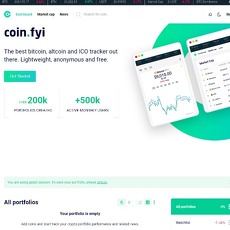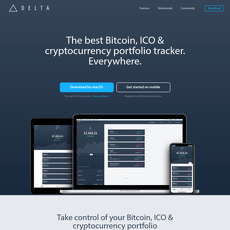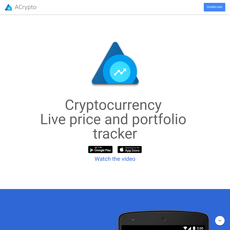Blockfolio Review
Blockfolio
blockfolio.com
Blockfolio.com: Everything You Need to Know About Them (With FAQ)
Ever wondered what happened to the Blockfolio app? Maybe you opened it one day and found yourself staring at something completely unfamiliar. Or perhaps you're frustrated because it just doesn't "feel" the same anymore. If that sounds like you, you're not alone.
For years, Blockfolio was the go-to app for crypto enthusiasts to track their portfolios. But if you’ve been out of the loop, you might feel like it suddenly disappeared into thin air. So, what’s the deal? Let me break it down—I'll explain the major changes, the frustrations users are talking about, and why so many people are now looking for alternatives.
Problems and Changes Around Blockfolio
You’ve probably already noticed: Blockfolio isn’t what it used to be. What once felt like a simple, reliable app now feels like it’s heading in a completely different direction. But why exactly is that? Let’s get into it.
What Happened to Blockfolio?
Here’s the big twist: Blockfolio was acquired by the FTX exchange in 2020. If that came as news to you, you’re not alone—lots of users missed the memo too. After the acquisition, the app didn’t just stay as it was. It was rebranded as the FTX app, which caused a ripple effect of changes that had many long-time users scratching their heads.
The rebranding wasn’t just cosmetic—it came with a shift in the app’s focus. Instead of being a solo portfolio-tracking tool, Blockfolio slowly morphed into an exchange-oriented platform. But that shift left many users feeling disconnected. After all, not everyone who tracks their portfolios wants to trade directly within the same app.
Frustrations Users Faced Post-Rebranding
If you were a loyal Blockfolio user, there’s a good chance you encountered at least one of these major frustrations:
- KYC (Know Your Customer) and AML (Anti-Money Laundering) policies: A big chunk of users weren’t prepared for the extra verifications required post-rebranding. If you valued your privacy, this change might’ve felt intrusive.
- Changes to the feature set: Some tools that made Blockfolio special were overshadowed by the new exchange-focused direction. Features you once relied on probably don’t feel as seamless anymore.
- A loss of independence: Pre-acquisition, Blockfolio was unbiased and exchange-neutral, which allowed users from all corners of the crypto space to feel at home. With the FTX integration, that neutrality slipped away.
It’s clear these changes weren’t everyone’s cup of tea. Loyal Blockfolio users felt alienated, and for many, that meant heading elsewhere for their portfolio-tracking needs.
Why Are Alternatives to Blockfolio in Demand?
It’s simple: when something that was working perfectly suddenly changes its course, people start looking elsewhere. Many users felt that the new FTX-centric experience took away what had once made Blockfolio so special—its simplicity and independence.
Here’s what many users are saying they want in an alternative:
- User-friendly design: Crypto can already get complicated. A portfolio tracker shouldn't add to that stress.
- Independence from exchanges: Not everyone wants their portfolio tracker tied to a specific exchange. Neutral apps often feel more flexible.
- Focus on privacy: Many crypto enthusiasts value their anonymity and seek tools that don’t require heavy compliance policies like KYC.
Even though Blockfolio gained tons of attention before the rebranding, its evolution into a different kind of tool left plenty of room for new, independent players to come forward. And trust me, those alternatives are out there.
So, where does this leave Blockfolio and its users? And how exactly did this once-beloved app become such a hot topic in crypto circles?
A Quick Backstory: What is Blockfolio?
You know how complicated managing your crypto investments can get. Blockfolio wasn’t just a tracker—it was like having your own financial assistant who didn’t sleep and always kept an eye on your crypto. If you’ve been in the crypto space for a while, chances are you’ve heard of it or even used it at some point.
But how did it climb the crypto ladder and become a fan-favorite app that everyone talked about? Let’s take a look at what made it special and the big turn it took after FTX stepped in.
How Blockfolio Became a Big Deal
Imagine this: You’ve got your portfolio spread across multiple cryptocurrencies, and every time you open your wallet, you’re manually calculating your gains or losses. Frustrating, right? Blockfolio turned that mess into magic by simplifying it.
- Simplicity: It wasn’t flashy or complicated—it worked, and people loved that. You could track your Bitcoin, Ethereum, or even that obscure altcoin without breaking a sweat.
- Price Alerts: Users could set up custom alerts so they never missed a price spike or a dip—a lifesaver during market swings.
- Customization: It catered to beginners and veterans alike. Whether you were checking prices once a week or obsessively monitoring hourly charts, it just fit your style.
Blockfolio hit 6 million users by doing one thing well: helping people stay on top of their crypto game. It wasn’t overwhelming, and it didn’t promise to be everything. It just stayed true to being a solid portfolio tracker.
The FTX Acquisition
In 2020, a major shakeup changed the script completely. FTX, a fast-rising crypto exchange, saw potential and acquired Blockfolio for a whopping $150 million. Think about that—a portfolio tracking app worth that much. It shows how influential Blockfolio really was.
Post-acquisition, something big happened: Blockfolio got rebranded as the FTX app. For some people, this felt like waking up to find out their favorite coffee shop now serves burgers instead. It was still there, but fundamentally different. As part of the FTX family, the app added exchange services which you’d either see as a bonus or a distraction, depending on how you used Blockfolio before.
“Change is the only constant, especially in crypto. What worked yesterday might evolve tomorrow.”
Was the $150 million move worth it for FTX? Well, it brought a massive user base into their ecosystem, which was clearly a smart business move. But what did this mean for the Blockfolio loyalists who weren’t necessarily interested in trading or being tied to an exchange?
What Makes Blockfolio Unique?
Even with all the changes, there are still a few things that set Blockfolio apart. Sure, it’s now operating under the FTX umbrella, but some of its DNA hasn't been lost entirely:
- User-Friendly Interface: The simplicity isn’t entirely gone. The app remains easy on the eyes and quick to navigate.
- Tracking System: You can still monitor multiple coins and get real-time updates—one of the key reasons people loved it in the first place.
However, the transition created a tug-of-war between being a tracking app and a full-blown exchange platform. For some old users, this shift wasn’t exactly what they signed up for. Others saw it as an evolution—a sign Blockfolio was leveling up.
So, was this transformation a bold win or a misstep? Well, let’s think about it: What do crypto enthusiasts look for in an all-in-one app? Is it the ease of tracking, the thrill of trading, or maybe both? And how does it compare to today’s leading crypto apps post-Blockfolio rebrand?
Grab your coffee (or crypto wallet) and get ready—next, we’ll explore the features that kept people hooked and the ones that left them scratching their heads.
Features You Need to Know About Blockfolio (Now FTX App)
Ever sat down with your coffee, peeking at your crypto portfolio, only to realize the app you trusted isn’t what it used to be? That’s how many felt when Blockfolio transitioned to the FTX app. While it ruffled some feathers, the app still has some nifty features that deserve attention. Let’s explore what’s changed, what’s still around, and what might leave you scratching your head.
Portfolio Tracking
If you loved Blockfolio for its clean and straightforward tracking features, here's some good news—it’s still there. You can monitor multiple cryptocurrencies across your portfolio in real time. Whether it’s Bitcoin, Ethereum, or the not-so-mainstream altcoins you’re holding, the interface still keeps things neat and manageable. For many, this core functionality is enough to stick around.
The ability to track your entire portfolio in one place remains powerful. Remember the days of separate spreadsheets? Gone. But does it have the depth and independence it once had? That seems to be the big question among users these days.
Built-In Exchange Services
Here’s where things take a turn. The rebranding brought a feature that shakes things up—you can now trade directlyfrom the app. Thanks to its connection with FTX, there’s seamless integration between your portfolio and trading opportunities. No flipping between apps, no third-party platforms. Sounds convenient, right?
While this might be a dream come true for those who trust FTX for their trades, others argue it muddies the purpose of a portfolio tracker. After all, Blockfolio was once a pure tracker, and this shift might feel like walking into a coffee shop and being handed a full dinner menu.
Enhanced Security (But Mixed Reactions)
Let’s talk about the elephant in the room—security. With FTX branding comes advanced security protocols, including KYC (Know Your Customer) compliance. No one doubts the need for tight security, especially in the crypto world where breaches are an ever-looming threat. But here’s the twist: tighter security often feels restrictive. Why? Because practices like KYC and other compliance measures might feel at odds with the anonymity crypto stands for.
"Safety is golden, but not everyone likes its price."
There’s no denying the value of keeping your assets secure, but for some, the added hoops feel like a compromise on the app’s original appeal. It’s a tug-of-war in the community—you either embrace this added safety net or miss the simpler, less intrusive days of the old Blockfolio. What team are you on?
What’s Missing in the Current Version
And now, the bittersweet dose of reality—the features that didn’t make it to this new chapter. Remember when Blockfolio was all about portfolio tracking, with no extra layers to confuse you? Those days have passed. For crypto enthusiasts who simply wanted a purely tracking-focused experience, this rebranding might feel incomplete.
The introduction of trading functions makes sense for a platform seeking to expand, but it does dilute what some would call its uniqueness. Features like alerts and easy tracking still exist, yet they’re not the sole stars of the show anymore. Simplicity has taken a backseat, and not everyone is ready to switch gears.
So, does this shift serve users better, or has it alienated a core audience that loved what Blockfolio used to be? That leads us to the bigger question—was this transition worth it in the first place? Did users truly gain more, or is something special forever lost?
Curious to know if the pros of this transition outweigh the cons? Let’s see what the big picture looks like, next.
Benefits and Downsides of the Transition
When Blockfolio transitioned to what we now know as the FTX app, it wasn't without its fair share of reactions. Some loved the changes. Others? Not so much. Let’s break this down into what works and what, frankly, could’ve been done better.
The Good Stuff
Let’s be fair—there’s a reason some users clicked with the idea of a revamped Blockfolio under FTX. Here’s what stood out:
- Integrated Trading: One of the most prominent features added is the ability to trade directly from the app. No more hopping back and forth between your tracker and an exchange. If you’re someone who trusts FTX and you’re already into trading, this is a huge time-saver.
- Security Boosts: The transition brought stricter compliance measures, including KYC (Know Your Customer) and AML (Anti-Money Laundering) policies. It’s like having a reinforced front door to your digital assets.
As someone who keeps a close eye on the crypto scene, I can see how these features might appeal to users wanting both tracking and trading in one clean package.
The Drawbacks
But let’s not sugarcoat it. While some found joy in this upgrade, others were left scratching their heads—or worse, looking for a new tracker. Why? Here’s what didn’t sit well:
- Forced Trading Focus: Not everyone who used Blockfolio wanted to trade. It was one of the few apps that catered to “track-only” users brilliantly. Now with the trading features front and center, that simplicity feels lost.
- KYC Compliance Frustrations: Listen, I get it—security matters. But many in the crypto world still prefer staying anonymous. Being required to submit personal information didn't exactly win FTX points with privacy-focused users.
- Trust Issues: Let’s face it. With FTX tying Blockfolio’s fate to its exchange ecosystem, some users felt uneasy. There’s always that lingering thought: What if the app is no longer truly objective?
One user I came across put it perfectly: “Blockfolio used to be mine. Now, it feels like it belongs to FTX.” That kind of emotional disconnect explains a lot about why some might feel like something’s been taken away.
What Does This Mean for Crypto Enthusiasts?
This transition, whether good or bad, highlights one crucial thing for anyone managing their crypto portfolio: make sure you read the fine print. The world of crypto moves lightning fast. What starts as your go-to tracker can quickly become something entirely different.
"The secret to surviving the crypto world is staying adaptable."
Think about it. As crypto evolves, so do the tools you rely on. Blockfolio’s pivot might work brilliantly for some—but for others, it’s a classic case of “not what I signed up for.” It’s a signal to re-evaluate what you’re using to track your investments and if those tools align with your goals.
But that leaves a big question hanging in the air: if Blockfolio doesn’t work for you anymore, where do you go next? Don’t worry—I’ll cover some killer alternatives next. Some might even outshine the old Blockfolio.
What alternatives exist for Blockfolio?
Let’s be real for a second—when an app you loved changes so drastically it no longer fits your needs, you’re left asking, “What now?” If Blockfolio (or should I say the FTX app) doesn’t feel right anymore, don’t worry. You’re not stuck. The crypto world is full of amazing alternatives to pick from. Whether you’re looking for simplicity, diverse features, or just something that aligns with how you like to manage your portfolio, I’ve got some great options for you.
CoinStats: Trusted by over a million users
When you talk about dependable and user-friendly portfolio trackers, CoinStats always pops up in the conversation. It’s one of the top replacements for Blockfolio, and here’s why:
- Powerful tracking tools: You can monitor over 8,000 cryptocurrencies with real-time data from 300+ exchanges. And it’s not just tracking—CoinStats lets you connect to wallets and trade right from the app.
- Ease of use: You don’t need to be a tech wizard to use it. The clean interface is perfect for both newbies and seasoned investors.
- Custom alerts: Price notifications, portfolio updates, you name it. CoinStats helps you stay ahead of market movements with instant alerts.
With over a million people on board, CoinStats has earned a solid reputation. It’s clear why many see it as the gold standard for tracking alternatives.
Delta: Intuitive and packed with features
If CoinStats isn’t your cup of tea, there’s Delta—a crypto portfolio tracker that screams simplicity while still being feature-rich. Many call it the “ultimate portfolio app,” and it’s not hard to see why. Here’s what makes Delta shine:
- Comprehensive tracking: Whether it’s Bitcoin, Ethereum, or niche altcoins, Delta has support for thousands of assets. You can even track stocks if you're into traditional investments too.
- Transaction history: This feature is a big deal. Delta keeps a tidy record of every single trade, withdrawal, or deposit, so you always know where your money’s going.
- No exchange dependency: Unlike the FTX app, Delta stays independent. It doesn’t tie you to a single exchange, giving you more freedom to do crypto your way.
Delta's interface feels so smooth it’s almost addictive. It’s a refreshing pick for users frustrated by Blockfolio’s rebrand.
Other options worth checking out
Beyond CoinStats and Delta, the crypto space offers a wide selection of other tools that could suit your needs:
- Kubera: Known as a “wealth tracker” rather than just a crypto tracker, Kubera lets you monitor crypto alongside your stocks, real estate, and even debt. It’s a fantastic choice if you’re looking for a full financial picture.
- CoinLedger: Formerly CryptoTrader.Tax, this one doesn’t just track but helps you simplify everything for tax reports too. If you’ve been stressed about crypto taxes, CoinLedger might be the relief you’ve been waiting for.
- CoinGecko: While it’s often thought of as a market data website, CoinGecko also delivers essential tools for managing portfolios and setting price alerts.
- CoinMarketCap: Beyond its charts and rankings, CoinMarketCap has kept up with user demands by offering portfolio tracking and alert features too. It’s a solid option for those who love having everything in one place.
Here’s an idea to consider—a lot of these apps don’t just replace what Blockfolio used to offer; they go above it. Each one brings something unique to the table, whether it’s tax assistance, multi-asset tracking, or staying independent of major exchanges. There's something exciting about leveling up your tracking experience!
"The best tools don’t just adapt to your needs—they help you stay ahead of the curve."
If you’re feeling stuck, frustrated, or unsure which direction to take, doesn’t it make sense to explore these alternatives more deeply? The crypto world never stands still, and neither should you.
But wait, does switching to a new tool really solve every question you have? There’s more to this story. What if you could get quick and clear answers to all your burning questions about Blockfolio’s rebranding? Let’s keep going to uncover that next...
FAQs: Quick Answers to Your Burning Questions
Let’s face it—when apps we love change dramatically, we’re left with a stack of questions. And if you’re wondering about Blockfolio (now the FTX app), you’re not alone. Here are the key answers you've been searching for, all in one spot.
What happened to the Blockfolio app?
The big twist here was the 2020 acquisition of Blockfolio by FTX. After that, Blockfolio said farewell to its old name and was rebranded as the FTX app. While some features stayed, the overall purpose shifted from being a crypto tracking tool to serving as a trading-focused platform.
Why does this matter? Because loyal users were expecting one thing—a tracker they could rely on—and got something else entirely. It’s a classic case of “what worked before, doesn’t work the same anymore."
What’s the new name for Blockfolio?
No wild guessing needed—the app now goes by the name FTX. Straightforward, but let’s be real for a second: if you’re still calling it Blockfolio out of habit, you’re not alone. Old names stick, just like how people still say "Google it" instead of "search for it."
What is a good alternative to Blockfolio?
Here’s where it gets interesting—there are quite a few. If you’re missing the old Blockfolio or looking for a new solution that fits your needs, check these out:
- CoinStats: It’s packed with advanced portfolio tracking and insights, and over a million users swear by it.
- Delta: Think sleek, easy-to-use, and super reliable for keeping tabs on your crypto portfolio.
- Kubera: A lesser-known gem but incredibly versatile. It's not only for crypto but tracks traditional investments too.
Need others? You can also check powerhouses like CoinLedger or get analytical with platforms like CoinGecko and CoinMarketCap. At the end of the day, the right tool will depend on what you value—simplicity, features, or independence?
"Finding the right crypto tracker is not just about tracking investments—it's about having a system you can trust."
Now, here’s the million-dollar question—are you relying on tools that truly simplify your crypto journey or ones that bring extra complexity? And what other resources are out there to help level up the way you manage, learn, and explore crypto? Let's check that out next.
Resources to Help You Track Your Crypto Efficiently
With everything happening in the crypto space—price swings, exchange drama, and endless new projects—having the right tools at your fingertips is not a luxury, it’s a necessity. If you’ve felt lost after changes in popular apps like Blockfolio, don’t worry, there are plenty of other resources to help you keep your portfolio on track.
Long-Standing Crypto Trackers
Let’s talk about crypto trackers that don’t just match Blockfolio’s old features but go above and beyond. Apps like CoinStats, CoinLedger, and Kubera are powerhouses when it comes to tracking and managing your investments. These tools have earned trust for their reliability and innovation:
- CoinStats: Sync your wallets and exchanges in seconds while accessing insightful reports on your portfolio. CoinStats even supports DeFi tracking if you’re exploring the decentralized frontier.
- CoinLedger: It takes things a step further by helping you with crypto taxes, which is a feature that’s often overlooked. Nobody wants to get blindsided during tax season, right?
- Kubera: A minimalist tracker that makes managing not just crypto but all your financial assets effortless. It brings a sense of calm to the chaos of portfolio tracking.
These platforms set a new benchmark in the space, showing everyone what’s possible when user needs come first. Isn’t that what we’re all looking for?
Educational Platforms
Tracking your portfolio is great, but what about understanding market trends and making smarter decisions? That’s where tools like CoinGecko and CoinMarketCap shine. These aren’t just trackers—they’re cryptoverse encyclopedias.
- CoinGecko: Beyond prices and charts, it offers fundamental insights like market cap rankings, historical data, and a breakdown of tokenomics.
- CoinMarketCap: With its user-friendly site and app, you can explore trending coins, analyze market cap dominance, and read up on the latest crypto events. Just knowing where the market is heading can make a world of difference.
As Mark Twain once said, “The secret of getting ahead is getting started.” Well, starting with the right education can save you from costly mistakes later on.
Combining News and Tools
Now here’s the thing—sometimes just having an app isn’t enough. What if you could combine tools for portfolio management with up-to-date news in one place? That’s where trusted sites like Cryptolinks come in handy. You get honest reviews, expert recommendations, and a finger on the pulse of the crypto world.
Bringing together analytics and headlines keeps you ready for anything—whether it’s a bull run or a market correction. Bookmark your go-to sources, and don’t miss a beat.
But wait… what happens when your app of choice runs into issues like syncing errors or security breaches? How can you troubleshoot those problems without losing your mind? Keep reading, because I’ve got you covered next.
Troubleshooting Common Blockfolio Concerns
Let’s face it—dealing with a crypto app can sometimes be frustrating, and Blockfolio (or the FTX app) is no exception. Whether it’s syncing problems messing with your portfolio or concerns about security, you’re not alone. I’ve seen these issues pop up time and time again, and while they can be annoying, there are ways to handle them. Let’s break it all down and keep your crypto journey smooth.
Syncing Issues? Let’s Get It Sorted
One of the most common complaints I’ve heard from users is their portfolio not syncing correctly. Imagine your entire investment tracker failing to update—it’s stressful, right? If this happens to you, don’t panic just yet. Here’s what you can do:
- Double-check your account settings: Ensure the wallet or exchange integration details are correct. A tiny mistake here can throw everything off.
- Clear your app’s cache: It’s surprising how often this fixes syncing hiccups.
- Update the app: Outdated versions can cause unnecessary trouble, so make sure you’re running the latest release.
If none of these methods work, consider reaching out to customer support. Sure, waiting for a response isn’t fun, but it’s better than guessing in the dark.
Worried About Account Security? You Should Be
The FTX rebranding brought tighter security protocols, which is good in theory—but it also raised concerns for some users. People have asked me whether their accounts are truly safe. My answer? As safe as you make them. Here are a few pro tips to control your security:
- Enable Two-Factor Authentication (2FA): Seriously, this should be non-negotiable. It’s extra protection against bad actors.
- Use unique, complex passwords: If you’re still using “crypto1234,” we need to talk.
- Keep your app updated: Updates often include important security fixes.
If you’re still uneasy, check the app’s privacy policy and security measures. Know what’s being shared and stored—that peace of mind is priceless.
Still Hunting for the Perfect Crypto Tracker?
Look, I get it. A tracker that doesn’t feel right can be super frustrating. While Blockfolio/FTX has its ups and downs, sometimes it’s worth exploring alternatives. Apps like CoinStats and Delta have become favorites among users looking for a more flexible or exchange-independent experience. And honestly, finding the perfect match often means testing out more than one app.
Here’s a trick: keep a shortlist of features you can’t live without. Is it real-time updates? No KYC? An intuitive interface? Match those must-haves to what each tracker offers, and you’ll likely find the gem you’ve been searching for.
Speaking of finding the right tools, have you ever wondered about the bigger picture? What are the ultimate traits every crypto tracker should have? Let’s take a look at that next…
What Every Crypto Tracker User Should Consider
Let’s face it—crypto tracking tools are a bit like sidekicks. They’re helpful when they fit your needs but can become a hassle when they don’t. Whether you’re still using Blockfolio (now the FTX app) or you’ve moved on to an alternative, there are some universal lessons we can all take away about choosing the right tracker for your crypto journey.
The Importance of Independence
Here’s something many crypto enthusiasts overlook: not every portfolio tracker needs to be connected to a major exchange. Sure, having built-in trading features can be useful for some traders, but for others, it’s just overkill. Many users loved Blockfolio for being a tracking-first app back in its day. It was simple and didn’t try to push you into trading—something a lot of people miss now.
If you’re looking for a tracker today, consider what you actually value. Do you want to keep things minimal and focused purely on tracking? Or are you okay with a tracker doubling as a trading platform? There’s no right or wrong answer—it’s about your preferences. Apps like CoinStats and Delta, for example, keep their independence intact while still delivering solid tracking features. Sometimes separating your portfolio management from trading platforms can reduce unnecessary stress, especially if you're just trying to monitor your holdings.
Staying Flexible
If there’s one thing the crypto world keeps teaching us, it’s this: adaptability is everything. The tools you trust today might not meet your needs tomorrow. Just think about how Blockfolio evolved after the rebranding. While some users stuck with it, others felt forced to find alternatives because their needs changed. Guess what? That’s perfectly okay.
A pro move here is to avoid locking yourself into one app or platform. Use tools that let you easily export or back up your data so you can switch without a headache if something stops working for you. Flexibility also means staying open to trying new tools as they hit the market. The best app for you may still be just around the corner. Kubera, for instance, has been gaining popularity for offering not just crypto tracking but also other asset tracking options like stocks and cash flow management.
Final Thoughts on Blockfolio/FTX
Let’s zoom out for a second. The story of Blockfolio isn’t just about an app changing its name or focus—it’s a glimpse into how fast the crypto space evolves. Something that feels perfect today could look very different in a year or two. The FTX app is proof of that.
Whether you’re still using FTX or you’ve moved on, the most important thing is to stay in the driver’s seat. Don’t settle for tools that don’t fit your goals or values. Crypto is all about empowerment—you choosing what works for you, not the other way around.
So, what should you do next? Start by asking yourself the tough questions: Is your tracker helping you, or holding you back? Are you comfortable with the level of security and control you have? And most importantly, are you prepared to adapt as the market evolves?
At the end of the day, your portfolio tracker is just a tool. It should make your journey smoother, not more complicated. Keep exploring, stay flexible, and don’t be afraid to switch things up when something better comes along. After all, you’re not just tracking numbers—you’re managing your future in a fast-moving, unpredictable world.






